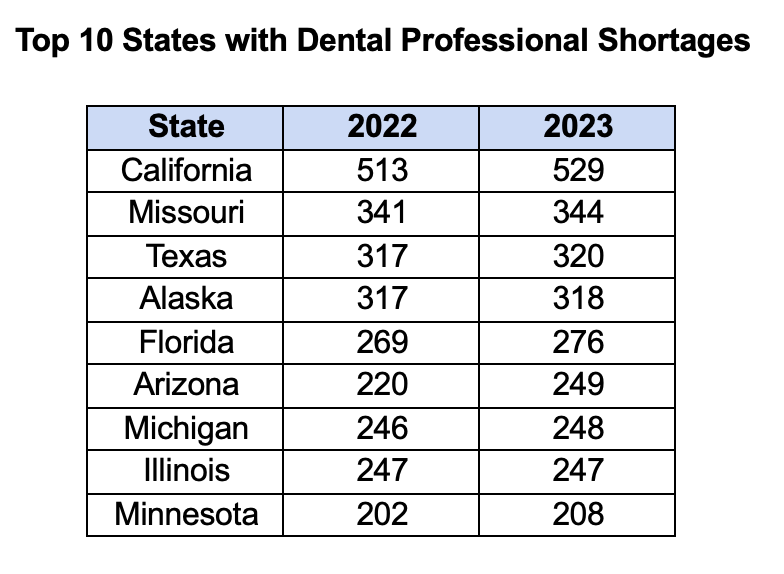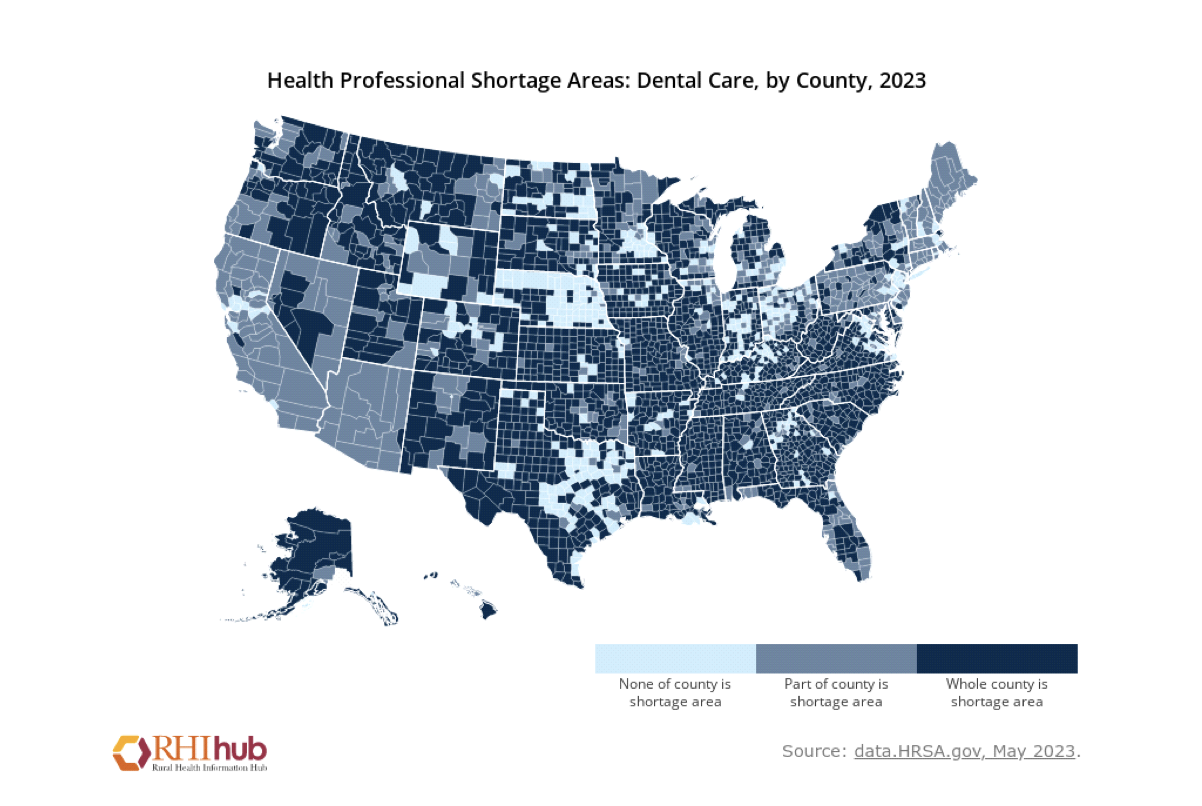
There's a dental workforce shortage that's caused a 10% drop in overall practice capacity, impacting states across America.
By Theresa Ahearn
Currently, there is a notable shortage of dental professionals across the United States, particularly in the fields of dental assisting and hygiene. This shortage poses significant challenges for dental practices, resulting in vacant positions, limited availability of high-quality oral healthcare, and disruptions in scheduling appointments.
Additionally, the difficulty in finding a dentist adds an extra burden for patients, often discouraging them from seeking essential dental treatment. This problem is particularly pronounced in rural areas where the shortage of dental experts is keenly felt. This scarcity of skilled professionals was initially linked to the repercussions of COVID-19, but recent research has unveiled that the shortage of dental professionals goes much deeper.
Looming Retirements and Compensation Trends
In October 2022, the ADA Health Policy Institute (HPI) partnered with the American Dental Assistants Association (ADAA), American Dental Hygienists' Association (ADHA), the Dental Assisting National Board (DANB), and IgniteDA to complete a study that looked very closely at this issue. Their findings underscore that the deficit in the dental workforce has persisted as a longstanding issue, showing no signs of resolution.
According to their findings, the decrease in enrollment for dental assisting programs started as early as 2015 and was further exacerbated by the pandemic's effect on dental hygiene program enrollments. Though enrollment programs have begun to recover, a significant proportion of dental assistants (33.7%) and dental hygienists (31.4%) are contemplating retirement within the next five years. Moreover, the research highlighted that while many dental professionals are content with their current roles, almost half received moderate raises ranging from 1% to 3% in the past year.
A Nationwide Problem

This shortage of dental professionals isn't localized to a specific region but is a nationwide issue affecting various states. Data from the Health Resources and Services Administration indicates a need for 11,909 dental practitioners to address shortage areas in the U.S. A report from the Kaiser Family Foundation concerning dental care accessibility reveals disparities.
To the right is a comparison of dental professional shortage areas in 2023 and 2022 for the top 10 states with the highest shortage areas.
View all 50 states, including Washington, D.C., here.
Rural States Bear the Brunt of Dental Shortage
While not all of the top 10 states with the highest shortage numbers fall into the rural category, it's often more rural states that bear the brunt of the impact of dental shortages. States like Tennessee demonstrate the challenges caused by shortages of dental professionals which are evident in a significant portion of the population experiencing advanced disease, tooth loss, and associated complications.
According to a recent report by the Tennessee Justice Center, over 1 million adults in the state lack dental coverage, and only about half of the children on Medicaid receive dental care. Making things harder, there aren't enough dental professionals, especially in rural areas. It becomes more challenging to get quality dental care when you have to travel far or wait a long time to be seen.
The Rural Health Information Hub has taken a significant step to spotlight this issue through an interactive map that draws upon data sourced from the Health Resources & Services Administration. This map delineates Health Professional Shortage Areas (HPSAs) related to Dental Care at the county level, offering a comprehensive overview. Counties are categorized based on their positioning within HPSAs, whether fully enveloped, partially affected, or unaffected. This organized information is presented with the aid of tags such as County-by-county data, Dental workforce, Health workforce shortage designations, and Oral health.

The interactive map's insights clearly show regions characterized by rural attributes have a higher concentration of entire counties grappling with shortage areas. This scenario is particularly alarmingly true in smaller states with limited populations, where the repercussions of dental shortages are magnified.
Future Outlook and Creative Solutions
Dental shortages in various states prompt innovative solutions, with dental experts collaborating with local health groups and non-profits to enhance dental care access. In March 2023, a consortium of dental organizations penned a letter urging the U.S. Senate to address healthcare workforce shortages, specifically in dental care. They advocated increased funding for the Oral Health Workforce Development Program to recruit and train dental hygienists and assistants, enhancing oral healthcare accessibility.
In May 2023, the Delta Dental of Colorado Foundation allocated $5 million to expand dental hygiene programs across colleges, addressing workforce shortages. Grants target diverse student populations, aiming to bridge the workforce gap.
Dental communities in Oregon are urging legislators to allocate $20 million to strengthen the workforce of essential dental hygienists and assistants. House Bill 2979 proposes $20 million in funding for dental professional training amid shortages, prioritizing "high-need areas" to address disparities in training opportunities, especially in rural regions.
Although these are all the right steps as demographics change, more research is needed to prepare for future challenges. Strategies include flexible scheduling, hiring assistants, optimizing productivity, or transitioning to alternative compensation structures.
The Future of Dental Care Access in the United States
The shortage of dental professionals is trending in the wrong direction. As a result, states lack dental access, and a considerable portion of dentists, almost one-third of them, struggle to uphold full schedules of appointments. Given these challenges, proactive measures must be taken by dentists and dental professionals to tackle the ongoing workforce shortages.
Collaborative efforts between dental organizations and governmental bodies can play a pivotal role in devising strategies to stimulate enrollment and offer financial support to aspiring dental professionals. Through collective efforts to augment the pool of skilled dental personnel, the industry can look forward to alleviating the strain caused by the persistent workforce shortfall and ensuring sustained accessibility to high-quality dental services for the population.
If you're not yet subscribed to receive the Incisor newsletter, filled with cutting-edge dental news sent directly to your inbox twice a month, you can do so here.
Author: Theresa Ahearn is a freelance writer currently residing in Oak Ridge, Tennessee. She received her Bachelor of Arts from the New York Institute of Technology and her Master of Science from Central Connecticut State University.




